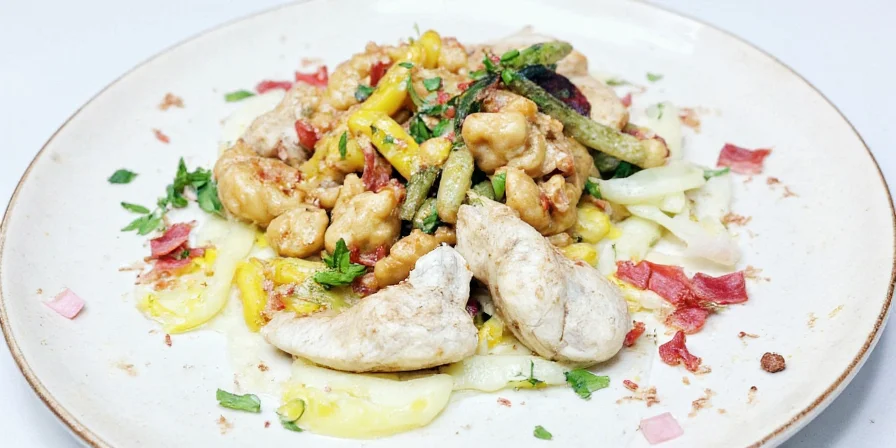Perfect Pork Shoulder Seasoning Recipe: Simple 5-Ingredient Blend for Juicy, Flavorful BBQ
If you're searching for the best pork shoulder seasoning, start with this foolproof blend that guarantees tender, flavorful meat every time. For a 5-pound pork shoulder, combine 1.5 tablespoons kosher salt, 1 tablespoon black pepper, 2 tablespoons paprika, 1 tablespoon brown sugar, and 1 teaspoon cumin. This ratio delivers perfect bark formation without burning, maximizes moisture retention, and creates deep flavor penetration. Apply this mixture liberally to all sides of the meat, then let it rest uncovered in the refrigerator for at least 1 hour (or up to 24 hours for even better results) before cooking. This straightforward approach solves the most common pork shoulder seasoning problems: dryness, bland flavor, and poor bark formation.

Photo: Your starting point—seasoning strategy begins before heat application
Why This Simple Pork Shoulder Seasoning Works (The Science Simplified)
This seasoning blend succeeds where others fail because each ingredient serves a specific chemical purpose that enhances your final result. Salt penetrates muscle fibers to lock in moisture through osmosis. Black pepper's piperine compounds enhance savory perception without overwhelming heat. Paprika provides stable color during long cooks, while brown sugar caramelizes at 320°F to create the perfect bark. Cumin binds to fat molecules, ensuring flavor stays through the rendering process. Unlike generic spice mixes, this precise ratio balances flavor development with practical cooking constraints.
Basic Pork Shoulder Seasoning Measurements (5lb Cut)
| Spice | Function | Measurement |
|---|---|---|
| Salt | Moisture retention1.5 tbsp | |
| Black Pepper | Umami enhancement1 tbsp | |
| Paprika | Color preservation2 tbsp | |
| Brown Sugar | Bark formation1 tbsp | |
| Cumin | Flavor retention1 tsp |
3-Step Application Method for Maximum Flavor
- Dry Brine (Optional but Recommended): Apply 50% of the salt 12-24 hours before cooking. Refrigerate uncovered to dry the surface, which accelerates bark formation.
- Rub Application: Massage the complete seasoning blend into all surfaces of the pork shoulder, including any crevices in the fat cap. Don't be shy—use enough to create a thin, even layer.
- Rest Period: Let the seasoned meat rest for at least 1 hour at room temperature before cooking to allow flavors to penetrate and the surface to stabilize.

Photo: Proper seasoning application ensures even bark development during cooking
Common Mistakes That Ruin Pork Shoulder Seasoning
- Using pre-mixed rubs: Commercial blends often contain anti-caking agents that block flavor penetration. Mix fresh rubs for best results.
- Not enough salt: Proper seasoning requires more salt than you might expect (1.5 tbsp for 5lb shoulder) for moisture retention.
- Applying sugar too early: If cooking at low temperatures, wait until internal temperature reaches 140°F before adding sugar-containing rubs to prevent burning.
- Rubbing on wet meat: Pat the pork shoulder completely dry before applying seasoning for better adhesion.
- Skipping the rest period: Rushing to cook immediately after seasoning prevents proper flavor integration.
Regional Pork Shoulder Seasoning Variations
| Style | Simple Modification | Best Cooking Method |
|---|---|---|
| Texas | Reduce sugar, increase pepperSmoker | |
| Kansas City | Add 1 extra tbsp brown sugarSmoker | |
| Mexican | Add 1 tsp lime zest + 1/2 tsp chipotleSlow Roast | |
| Korean | Add 1 tbsp gochujang pastePressure Cooker | |
| Caribbean | Add 1 tsp allspice + 1/2 tsp cinnamonGrill |

Photo: Simple regional adaptations to customize your pork shoulder seasoning
Advanced Techniques for Pitmaster-Level Results
Once you've mastered the basic blend, these professional techniques will take your pork shoulder to the next level:
- 24-Hour Dry Brine: Apply half the salt 24 hours before cooking, then apply the complete rub 1 hour before cooking for superior moisture retention.
- pH Optimization: After dry brining, lightly mist with apple cider vinegar (diluted 1:4 with water) to temporarily open muscle fibers before final rub application.
- Layered Application: Apply 70% of rub, wait 15 minutes, then apply remaining 30% for controlled flavor saturation.
- Fat Cap Integration: Score fat cap in diamond pattern, then rub spices directly into incisions for deep flavor infusion.
Tools You Actually Need for Perfect Seasoning
- Mesh Shaker: Ensures even particle distribution without clumping
- Butcher Paper: For wrapping during the stall phase to maintain bark integrity
- Digital Scale: For precise spice measurements (volume measurements vary)
- Thermometer: Critical for timing sugar application during cooking
- Pastry Brush: For applying light misting of apple juice during the stall if needed

Photo: Proper seasoning yields structural integrity during pulling, not mushiness
Frequently Asked Questions
How much seasoning do I need for a pork shoulder?
For a standard 5-7 pound pork shoulder, use approximately 4 tablespoons total seasoning (about 1/4 cup). The key ratio is 1.5 tablespoons salt per 5 pounds of meat, with other spices proportionally adjusted. Too little seasoning won't penetrate properly, while too much can make the meat overly salty.
Should I use garlic powder in pork shoulder seasoning?
Yes, but add it just before cooking. Garlic powder's flavor compounds degrade during long smoking periods. For best results, apply 1 teaspoon garlic powder as part of your final seasoning application 30-60 minutes before placing the meat in your cooker.
Can I make this seasoning without sugar?
You can, but you'll miss out on critical bark formation. Sugar caramelizes during cooking to create the flavorful crust. If avoiding sugar, increase paprika to 3 tablespoons for color development and add 1/2 teaspoon instant espresso powder to mimic some browning effects without sweetness.
How long before cooking should I apply the rub?
For best results, apply the complete rub at least 1 hour before cooking. For even better flavor penetration and moisture retention, use a two-stage approach: apply 50% of the salt 12-24 hours in advance (dry brine), then apply the complete rub 1 hour before cooking. Avoid applying rubs more than 24 hours in advance as this can make the surface too salty.
Final Tips for Perfectly Seasoned Pork Shoulder Every Time
Great pork shoulder seasoning combines simple ingredients with proper technique. Start with the basic 5-ingredient blend, master the application method, then experiment with regional variations as you gain confidence. Remember that proper seasoning isn't just about flavor—it's about creating the perfect chemical environment for moisture retention, bark formation, and flavor development throughout the cooking process. Whether you're using a smoker, oven, or grill, this approach ensures restaurant-quality results with minimal effort. The difference between good and exceptional pulled pork starts long before the meat hits the heat—it begins with thoughtful, strategic seasoning.











 浙公网安备
33010002000092号
浙公网安备
33010002000092号 浙B2-20120091-4
浙B2-20120091-4